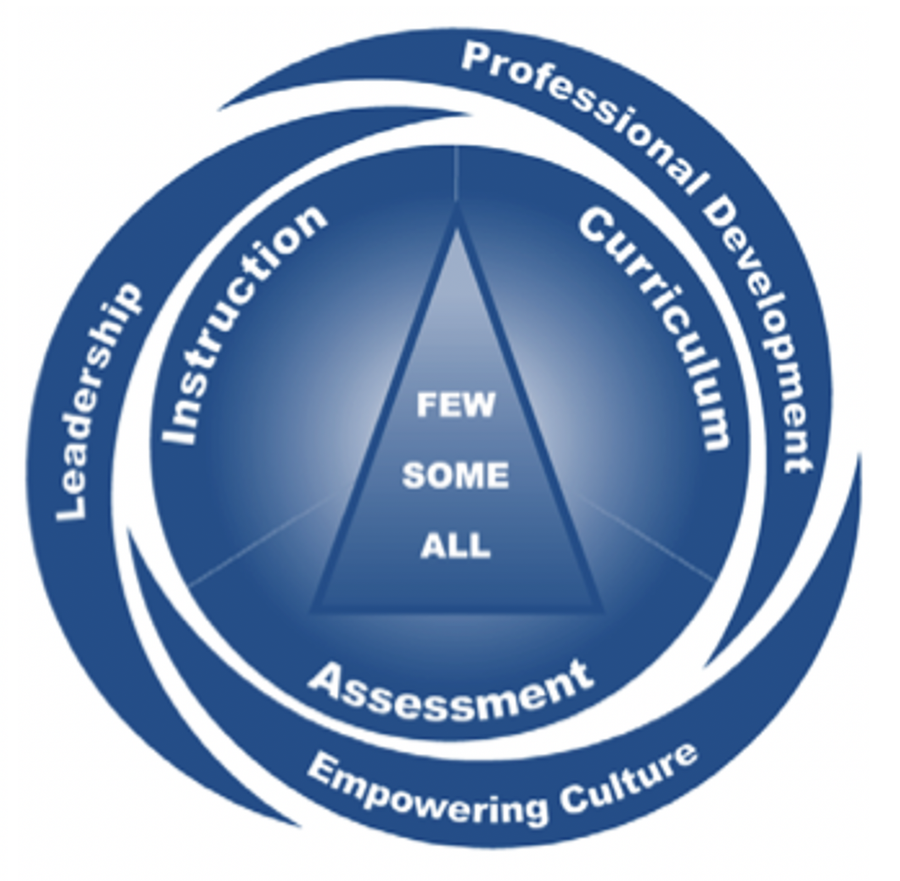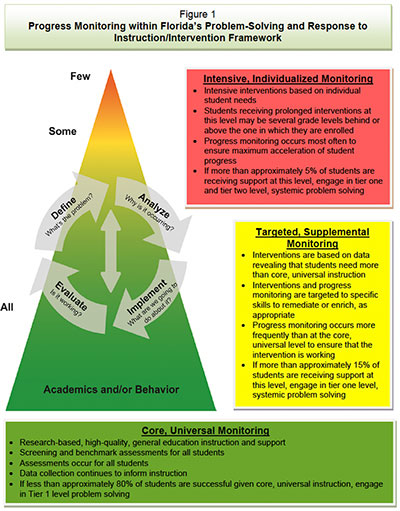Multi-tiered System of Supports (MTSS)
This Foundational Concept can be found in the following module pages:
- Assessment, Biases in Tests and in the Interpretation of Scores
- Learning Supports, Multi-Tiered System of Supports (MTSS)
Multi-tiered System of Supports (MTSS) aka Response to Intervention (RTI): A Framework for Meeting the Instructional Needs of All Learners
A Multi-tiered System of Supports (MTSS) is an educational framework for meeting the varied needs of students. Originally construed as a way to identify students with learning disabilities and called Response to Intervention (RTI or RtI), MTSS provides a way to decide when to offer interventions with varying levels of intensity. According to the National Center for Learning Disabilities (2016, para. 1), “students’ progress is closely monitored at each stage of intervention to determine the need for further research-based instruction and/or intervention in general education, in special education, or both.”

When used effectively, a Multi-tiered System of Supports (MTSS), provides a strategy for improving learner academic and behavioral outcomes across general and special education; it is not primarily an approach to special education or a way to identify students for placement in special education. For example, the Kansas Department of Education, a leader in promoting the statewide use of MTSS, defines MTSS as a “coherent continuum of evidence based, system-wide practices to support a rapid response to academic and behavioral needs, with frequent data-based monitoring for instructional decision-making to empower each Kansas student to achieve to high standards” (KDSE, 2012, p. 1).
Like Kansas, the state of Florida uses an MTSS framework to support systems-level change (i.e., change across the classroom, school, district, and state) by improving the capacity of school districts to support higher levels of learning for all children, including students receiving special education services.
Both RTI and MTSS rely on a data-based problem-solving process to integrate and support the provision of both academic and behavioral instruction and intervention. According to the Florida Department of Education (2012, para. 1), “integrated instruction is delivered to students in varying intensities (multiple tiers) based on student need. ‘Need driven’ decision-making seeks to ensure that district resources reach the appropriate students (schools) at the appropriate levels to accelerate the performance of ALL students to achieve and/or exceed proficiency.”
Context and Impetus for Change
Response to intervention (RTI) was first mentioned in the federal Individuals with Disabilities Education Improvement Act (IDEIA) of 2004 as part of new requirements for identifying children with specific learning disabilities (SLD). The provision permitted school districts to consider a child’s response to scientific, research-based intervention as part of the SLD determination process, as an alternative to relying on identifying a severe discrepancy between intellectual ability and achievement.
The use of RTI as a factor in determining eligibility for students suspected of having SLD gained momentum as an outgrowth of the 2002 President’s Commission on Excellence in Special Education. Commission members heard testimony from a variety of experts, the majority of whom expressed concern over the use of IQ tests to identify discrepancies between ability and achievement, and the longstanding ‘test and place’ model wherein children not successful in general education were referred for testing, found eligible (or not), and placed in special education. The need for a different approach – one that focused on prevention and improved student outcomes, regardless of categorical label – was clearly indicated.
The practice of using RTI as an alternative to the discrepancy model began in 2006. Its use as a model that could and should be applied to all learners, not only those with suspected disabilities, evolved into the development of MTSS as a broader approach to improving student outcomes.
Essential Components and Tiers

The use of a tiered problem-solving model, with each tier differentiated by the intensity of services provided, is at the heart of all MTSS models (including RTI).
In general, problem-solving models that seek ways to improve instructional strategies and learning outcomes for students include four steps.
- First, educators define the most important goals (e.g., a change in a student’s behavior or academic learning). Defining goals in measureable ways is a critical part of the process.
- Second, educators investigate why the goals have not yet been attained. This step is important as a basis for identifying strategies that will either work around or work through existing impediments.
- Third, educators develop and implement a plan. The plan involves the use of strategies that have a strong likelihood of working.
- Finally, following the implementation of the planned strategy, educators evaluate its effectiveness in relation to the important goals they originally identified.
Three tiers comprise a tiered approach, which can be used for both academic and behavioral interventions. Florida’s model provides a good illustration. (See the diagram above.) Note that the Tier descriptions below are adapted from the Florida Department of Education’s MTSS Implementation Components: Ensuring Common Language and Understanding.
Tier 1. The intent at Tier 1 is that every student should receive strong core instruction in reading and mathematics that is aligned with the state’s academic content standards. Florida notes that while Tier 1 denotes what “ALL” students get in terms of instruction and student supports, services at this tier should be based on the needs of the students in a particular school. For example, some schools may require more time than other schools in particular core curriculum areas based on student demographics (e.g., readiness, language, economic factors) and student performance levels to ensure that all students reach and/or exceed state proficiency levels. When core instructional programs are implemented as designed, “around 75-80% of children should, theoretically, be expected to reach successful levels of competency through Tier 1 delivery” (Shapiro, 2016, para. 3).
Tier 2. Tier 2 services – what “SOME” students receive in addition to core instruction – are intended to support improvements in student performance in relation to expectations for all students under Tier 1. Tier 2 services are more intense, require additional time, and can be provided by a variety of educators (e.g., general education teachers, remedial teachers, behavior specialists, related services providers, and so on) in any setting.
Tier 3. Tier 3 services – what “FEW” students receive – are the most intense services and supports that can be provided to students because they are designed to address significant barriers to learning. Tier 3 services, typically provided to very small groups of students or even to individual students, require more time and a narrower instructional focus than Tier 2 services. Often they also require collaboration and coordination among general and specialized staff.
Shapiro (2016, para. 7) offers the following example in differentiating between a Tier 2 and Tier 3 service:
A 2nd grade student who has been placed into Tier 2 for reading may already have well-developed skills in phonics and alphabetic principles underlying the reading process but may be struggling with the development of fluency in reading connected text. By contrast, a similar 2nd grade student identified as being at high risk and placed into Tier 3 may lack the more foundational skills of decoding and need intensive work on phonics. Clearly, these two tiers are being differentiated based on the nature of the instructional program, which is directly matched to the student's level of identified risk.
A Deeper Dive: For more information, you might want to explore the following websites:
To learn about Florida’s RTI/MTSS framework, go to https://floridarti.usf.edu.
To find RTI resources, go to Intervention Central at https://www.interventioncentral.org/home.
For information about MTSS visit the AIR Center on Multi-Tiered System of Supports at: https://mtss4success.org.
References
Florida Department of Education. (2012). MTSS implementation components: Ensuring common language and understanding. Retrieved from https://florida-rti.org/educatorResources/MTSS_Book_ImplComp_012612.pdf
Kansas State Department of Education. (2012). Kansas MTSS fact sheet. Topeka, KS: Author.
National Center for Learning Disabilities. (2016). What is RTI? Retrieved from http://www.rtinetwork.org/learn/what
Prasse, D. P. Why adopt an RTI model? Retrieved from http://www.rtinetwork.org/learn/what/whyrt
Shapiro, E. S. (2016). Tiered instruction and intervention in a response-to-intervention model. Retrieved from http://www.rtinetwork.org/essential/tieredinstruction/tiered-instruction-and-intervention-rti-model